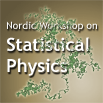Speaker
Paolo Sibani
(University of Southern Denmark)
Description
In recent experiments (Richardson et al. (2010), PLoS ONE
5(3): e9621. doi:10.1371/journal.pone.0009621)
ant motion out of the nest is shown to be a non-stationary
process
intriguingly similar to the so called aging dynamics,
of physical glassy systems.
Under different conditions, (Nouvellet et al.(2010), Journal
of Theoretical Biology 266, 573)
the same exit process is well described by a Poisson process.
To investigate possible mechanisms producing both types of
behavior, a model is introduced where
interacting agents, e.g. ants, move from one site to a neighbor
site on a finite 2D lattice.
The probability of each move is determined by the ensuing
changes of a utility function
conventionally dubbed 'energy'. The latter is a sum of
pairwise interactions
between agents, weighted by distance. Depending on how the
interactions are
defined and on a control parameter dubbed `temperature', the
dynamics either quickly converges to a stationary state,
where movements are a standard Poisson process, or may
enter a non-stationary
aging regime, where exits can be described in the way
suggested by Richardson et al., i.e.
as a Poisson process in logarithmic time, for short a
log-Poisson process.

